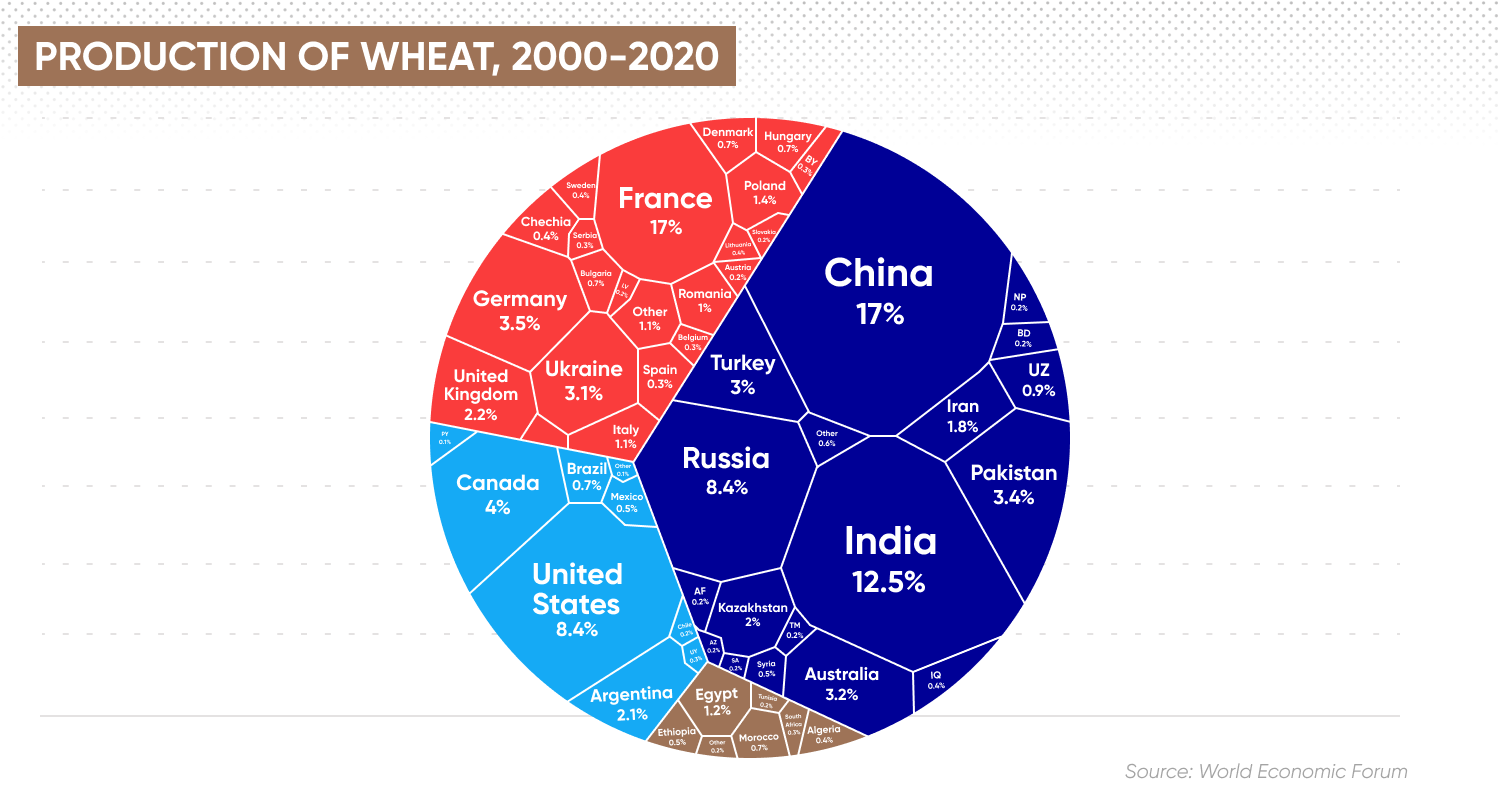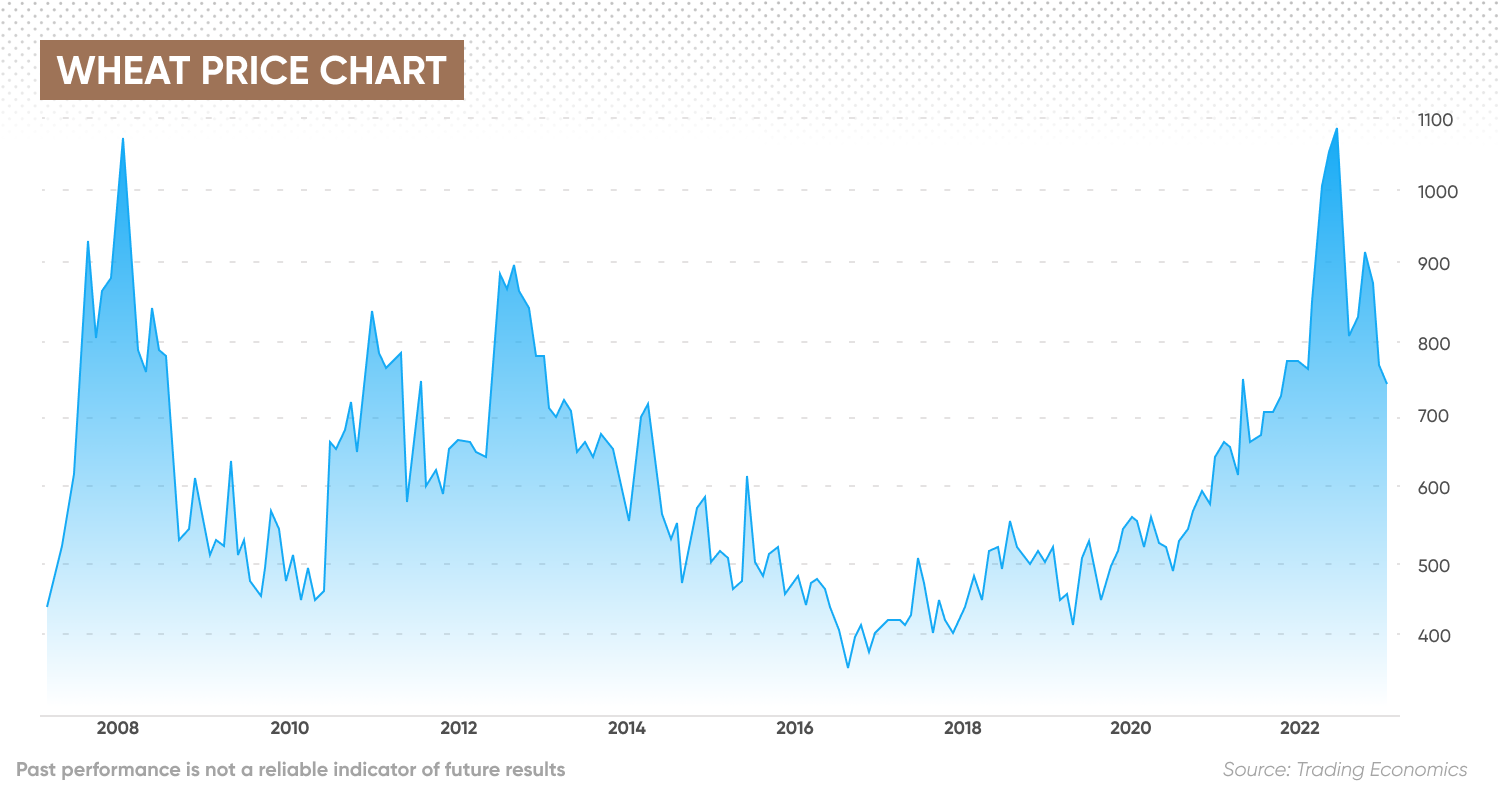Wheat price forecast 2022: Will it maintain its bullish momentum?
Anticipated higher supply has put downward pressure on wheat prices. Is wheat set for further falls?
Wheat prices have come under pressure in recent weeks as a result of the extension of a grain export agreement between Russia and Ukraine from the Black Sea region. The prospect of increased output from Australia, Kazakhstan and Russia has also weighed on the food staple.
At the same time, stock has remained tight, making wheat vulnerable to a price upswing. We look into historical prices, factors that affect a wheat price analysis and the latest wheat price forecast from analysts.
What is wheat? From bread to noodles
Wheat is a type of grass harvested for its edible grain, also known as a cereal grain. It’s one of the most widely planted staple crops in the world. The grain is processed into flour for making bread, pasta, noodles and more. It is also used for animal feed.
Wheat is thought to have been the first crop to have been cultivated in the Middle East around 10,000 years ago. Following maize, grain is the second most traded grain commodity and the second most produced grain for human consumption.
According to World Economic Forum data, China is the world’s largest wheat producer. The vast bulk is consumed domestically by the country’s 1.42 billion people. Russia is the world's third largest producer and the largest exporter. Australia, the United States, Canada, Argentina and Ukraine are other major producers. Major importers of wheat include Indonesia, Egypt, Turkey, China and Bangladesh

The six wheat varieties are based on protein content, growing season and cultivation area. They are: hard red winter wheat (HRW); soft red winter wheat (SRW); hard red spring wheat (HRS); hard white (HW); soft white (SW); and durum.
Wheat is traded using futures and options at the Chicago Board of Trade (CBOT), part of the CME Group. The group offers four wheat contracts: the main Chicago Wheat Futures and options, KC wheat, Black Sea Wheat, and Australian wheat futures and options.
Milling wheat is traded via futures contracts at the EuroNext in Paris. France is the EU’s largest wheat producer.
Wheat price performance 2021-2022
The wheat market witnessed an upswing in prices over 2021 due to a supply tightness as hot and dry weather during the growing season reduced output in Canada, the US and Iran. Strong demand and rising fertiliser prices caused by the high cost of natural gas contributed to the price rally in 2023.
Additionally, according to Gro Intelligence, Russia’s supply decreased after it levied export taxes on wheat in June and December 2021. The export taxes sought to deter exports and increase supply for the domestic market as the nation battled rising food inflation.
Wheat prices climbed to above $8/bushel in November 2021, the highest price since December 2012. According to historical wheat data provided by Investing.com, CBOT futures wheat prices increased 20.34% over 2021, as opposed to 14.6% in 2020.
In 2021/2022, global wheat output rose by 1% to 781 million tonnes from 773 million tonnes in 2020/2021, data from the International Grains Council showed.
Heightening supply worries following Russia’s invasion of Ukraine in late February sent CBOT wheat futures soaring to a record high of $13.6 per bushel on 8 March. Russia blockaded Ukraine’s Black Sea ports, which was the main route for shipping the invaded country’s wheat to the global market.
The US ban on Russian energy exports and the exclusion of several Russian lenders from the international payment system SWIFT were two Western sanctions that contributed to the record-breaking price.
According to the Food and Agriculture Organization of the United Nations (FAO), Russia shipped 32.9 million tonnes in 2021, accounting for 18% of global trade, while Ukraine exported 20 million tonnes, accounting for 10% of the global market.
Prices have pulled back since aArch’s record high after Russia and Ukraine agreed to reopen the Black Sea in July for grain exports, allowing Ukraine to resume shipments to the global market.
Expected higher production from main producers, particularly Australia and Kazakhstan, have applied downward pressure on wheat prices.
Latest wheat news: bumper crop, Black Sea reopens and soft demand
As of 5 December, CBOT wheat was trading at $7.66/bushel, having dropped about 0.47% year-to-date (YTD) and around 43.6% below the all-time high price in March.
Let’s examine factors that have contributed to falling wheat prices and whether there are any factors that could support them.
Australia’s bumper harvest to boost global output
The US Department of Agriculture (USDA) on 14 November revised up its global wheat production forecast for 2022/2023 by 1 million metric tonnes to 782.7 million metric tonnes (MMT), from 781.7 MMT in October. Expected higher output from Australia and Kazakhstan due to benign weather supported the upward revision.
Fitch Solutions forecast Australian growers to produce 34 million tonnes of wheat in 2022/2023. While that represented a 6.2% year-over-year (YOY) decline, it marked the country’s second successive bumper harvest with total output 40% above the five-year average, the consulting firm said in a note on 29 November.
Heavy rains in Western Australia and New South Wales, which account for 38% and 31% respectively of the country’s total wheat output, have raised concerns about the crop’s quality.
Black Sea exports resumption could add supply
On 17 November, Russia and Ukraine agreed to extend the Black Sea Initiative for another 120 days, starting from 19 November. The extension ensures more wheat will reach market.
Based on the Initiative’s Joint Coordination Centre (JCC), a total of 11.18 million tonnes of grain and other foodstuffs were exported from three Ukrainian ports: Odessa, Chornomorsk and Yuzhny/Pivdennyi, as of 17 November. Wheat accounts for 29% of total shipments, according to the centre’s data.
According to the UK’s Agriculture and Horticulture Development Board (AHDB) in a market report on 28 November:
Softening consumption
The USDA lowered its forecast for 2022/2023 global wheat consumption to 0.60 million metric tonnes to 785.1 MMT due to a decline in food, seed and industrial use.
The AHDB noted that the Covid-19 restrictions in China and recessionary fears also fuelled concerns over global demand for grains. China has removed some of the restrictions following widespread protests over the draconian zero Covid policy.
Global ending stock remains tight
According to the USDA’s Wheat Outlook for November, global ending wheat stocks were projected to rise 0.3MMT to 267.8 MMT, but it was still the tightest since 2016/2017.
Fitch Solutions forecast that wheat stocks to wheat stocks-to-inventories held by major exporters through 2022/ 2023 would be equivalent to less than eight weeks of average global wheat use.
The firm said the tight stock condition could raise the sensitivity of wheat prices to unexpected supply disruptions and short-run deteriorations in key harvest outlooks, such as those caused by extreme weather events and unpredictable rainfall fluctuations.
Wheat price forecasts for 2022 and beyond
On 1 December, Fitch Solutions’ wheat price forecast for 2023 expected the grain to trade around $8.6/bushel in 2023, dropping from estimated $9.33/bushel in 2022.
The CBOT wheat was forecast to trade at around $7.1553/bushel by the end of Q4 2022, before falling to $6.3838 in 12 months, according to a wheat price prediction by data aggregator Trading Economics.
The World Bank’s wheat price forecast saw the grain price drop to $410 per metric tonnes in 2023, from $430 in 2022, according to the Bank’s October’s Commodity Market Outlook 2022. It projected wheat prices to decline to $405/mt in 2024.
Fitch Solutions, Trading Economics, and the World Bank did not provide a long-term wheat price outlook beyond 2024 due to the unpredictable weather factor, uncertainty surrounding the development of geopolitical tensions, and the consumption pattern.
Wallet Investor had a bullish wheat price forecast, stating that the grain was a good long-term investment. According to the price forecasting service’ wheat was expected to trade around $9.55/bushel in December 2023.
Wallet Investor’s wheat price forecast for 2025 projected the price to be $12.53/bushel in 2025 and $15.26/bushel by November 2027. The service did not offer a wheat price forecast for 2030.
Final thoughts on wheat price forecast
Fitch Solutions, Trading Economics and the World Bank expected wheat prices to decline in 2023, while Wallet Investor projected prices would continue to rise.
It is important to note that analysts and algorithm-based predictions can be inaccurate. You should never use forecasts in place of your own research. Always conduct your due diligence by reading the latest news, analysts' notes and wheat data released by the official statistics office. Remember that past performance is no guarantee of future gains. And never invest money that you cannot afford to lose.
FAQs
Is wheat a good investment?
The wheat market can be volatile, as it is influenced by weather patterns. Excessive rains or drought affects yield. Conflicts can also affect output because farmers may abandon their crops for safety. Conflicts can also disrupt shipments, as seen in the Ukraine conflict.
Whether wheat is a good investment should depend on your investment goal, portfolio and the level of risk you are willing to take. Always do your research before investing, including reading news articles, regular data releases from statistical offices and analyst reports on wheat markets. And never trade money you can't afford to lose.
Will wheat go up or down?
Nobody is certain. Wheat prices were expected to fall in the next 12 months, according to Fitch Solutions, Trading Economics, and the World Bank. However, Wallet Investor predicted the opposite.
Always do your own research before making any investment decisions. Remember, past performance does not guarantee future returns. And never trade with money you cannot afford to lose.
Should I invest in wheat?
Whether you should invest in wheat is determined by factors such as your risk tolerance, portfolio size and composition, investment goals and timeframe, and market experience. Keep in mind that commodity markets, like any other financial markets, are volatile. And you should never invest money that you cannot afford to lose.
